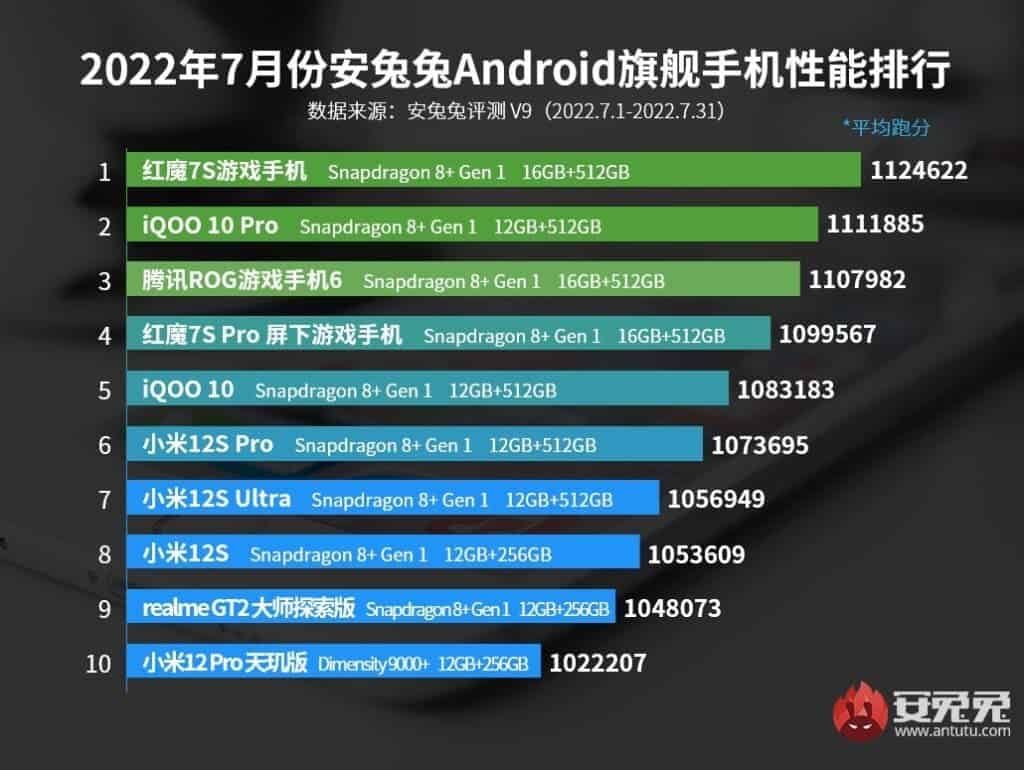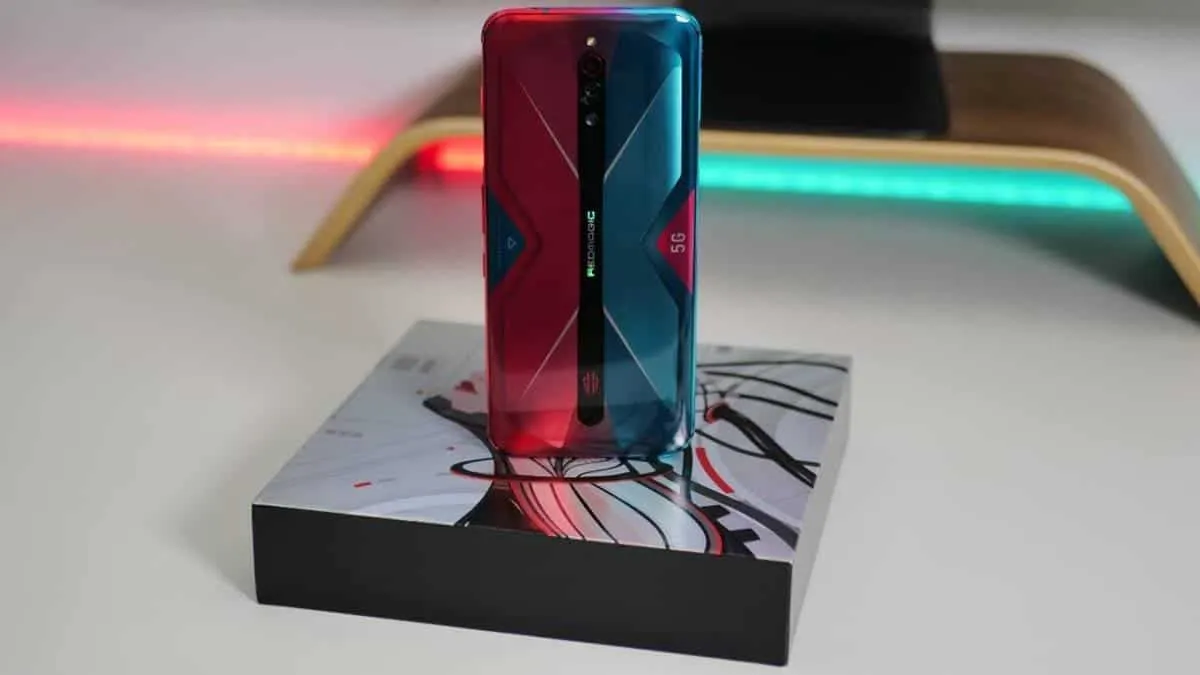As usual, AnTuTu has released its list of the best flagship smartphones for the month of July. This list contains the best flagship smartphones in terms of performance. Thus, the list technically assesses the chip and its optimizations. This time, the list is almost entirely dominated by Snapdragon 8+ Gen 1 smartphones. The list for this month is significantly different from the list for last month. This is because of the arrival of the Snapdragon 8+ Gen 1 SoC.

The first smartphone on this list is the Nubia Red Magic 7S Gaming smartphone. This flagship device comes with an active cooling that takes the running points to 1.12 million points. Another Nubia smartphone on the list is the Red Magic 7S Pro Gaming Phone with a running score of 1,09,9567. However, the Pro model of this series occupies the fourth position.
This list contains four Xiaomi smartphones including Xiaomi 12S, Xiaomi 12S Pro, Xiaomi 12S Ultra, and Xiaomi 12 Pro Special Edition. The Xiaomi 12S, Xiaomi 12S Pro, and Xiaomi 12S Ultra occupy the sixth, seventh, and eighth positions respectively. The Xiaomi 12 Pro Special Edition is the only smartphone on the list that does not use the Snapdragon 8+ Gen 1 SoC. The Xiaomi 12 Pro Special Edition is also the last (number 10) device on the list. This device comes with a Dimensity 9000+ flagship processor and it scores 1,022,207 points.
Snapdragon 8+ Gen 1 chips dominate the list
The flagship Dimensity 9000+ is based on the Dimensity 9000. The Plus model increases the frequency of the single ultra-large core X2 from 3.05GHz to 3.2GHz. Furthermore, the three large-core - A710s maintain the 2.85GHz while the small cores A510s also maintain the 1.8GHz frequency. The official claims that this gives the chip a 5% boost. The GPU is Mali-G710, and the official said that the performance has increased by 10%.
Purely from the paper parameters, in fact, there is not much difference between the Dimensity 9000+ and the Snapdragon 8+ Gen 1. However, in terms of the final performance, it is 100,000 points lower than the highest score of the Snapdragon 8+ Gen 1 SoC which is 1.12 million points.
Of course, the AnTuTu benchmark is closely related to the manufacturer's specifications such as adjustment and heat dissipation. It is not a simple SoC benchmark. In fact, compared to the Snapdragon 8+ Gen 1 of the Xiaomi Mi 12S series, there is not much difference between the two. There are speculations that some manufacturers will bring the performance of the Dimensity 9000+ to the extreme in the future. This chip will eventually compete with the Snapdragon 8+ Gen 1. However, the market seems to just prefer Snapdragon processors in flagship smartphones. It doesn't really matter how well other chips perform.
Qualcomm Snapdragon 888 was a "fire monster" and a disaster at best. However, many Android brands still preferred this chip to the more efficient Dimensity flagship processors. It became more evident with the Snapdragon 8+ Gen 1 and the Dimensity 9000. The Dimensity 9000 clearly outperforms the Snapdragon 8 Gen 1. However, the market still preferred the latter.
Top 10 flagship smartphones
1. Nubia Red Magic 7S & 7S Pro Gaming Phone
This flagship smartphone comes with the Snapdragon 8+ Gen 1 SoC coupled with up to 18GB of RAM. To significantly improve the performance of this device, Nubia adds a 10-layer multi-dimensional cooling system to this device. Furthermore, this device also incorporates an ICE 10.0 Multi-dimensional Cooling technology. This ensures that the heating within the device is reduced to the barest minimum. This smartphone also comes with an in-built fan with RGB LED lights on the Mercury and Supernova models. The Nubia Red Magic 7S Pro comes with a similar system as the regular model. However, it has a bugger battery and more weight.
2. iQOO 10 Pro
The iQOO 10 Pro also comes with a Qualcomm Snapdragon 8+ Gen 1 SoC. This flagship smartphone comes with up to 12GB of RAM and 512GB of internal storage. This device comes with a VC Liquid Cooling technology which keeps the temperature low and also improves the performance of the flagship Snapdragon 8+ Gen 1 SoC. Furthermore, this device uses a 3923 mm2 super large area heat spreader that covers the entire panel. In addition, this flagship smartphone comes with dual split-flow power pumps to ensure chip heat dissipation.
3. Asus ROG Gaming Phone 6
The Asus ROG Gaming Phone 6 also comes with a Qualcomm Snapdragon 8+ Gen 1 SoC. This flagship smartphone comes with up to 16GB of RAM and 512GB of internal storage. In addition to the internal heat dissipation system, this smartphone also supports the AeroActive Cooler. This device is a pocket-sized external cooling fan that simply clips onto the back of your phone, and actively delivers increased airflow to the case in the area around the CPU. This cooler actively and significantly reduces the surface temperature by up to a stunning 15°C1 and connects easily. This also contributes to the high performance of the flagship processor that this device holds.
4. Xiaomi 12S Pro, Xiaomi 12S Ultra, Xiaomi 12S & Xiaomi 12 Pro Special Edition
While the Xiaomi 12S series comes with the Snapdragon 8+ Gen 1, the Xiaomi 12 Pro special edition uses the Dimensity 9000+ flagship processor. The Xiaomi 12S series comes with a new leaf vein pump cooling system which improves the performance of the batter, charging, and chip performance. This also means that it improves the overall gaming performance of this chip. This technology is called the "leaf vein pump" because its design principle is similar to plant leaves. The VC homogenous heat plate comes with a coolant which reduces the heating effect. The thermal conductivity is 100% better and it reduces the temperature by 1.6°C compared to ordinary VC.
5. Realme GT2 Explorer Master Edition
The Realme GT2 Special Editio also comes with a Qualcomm Snapdragon 8+ Gen 1 SoC. This flagship smartphone comes with up to 12GB of RAM and 256GB of internal storage.






Place comments
0 Comments
You are currently seeing only the comments you are notified about, if you want to see all comments from this post, click the button below.
Show all comments